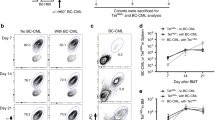Abstract
After allogenic transplantation of lymphoid cells into immunologically incompetent recipients, a graft-versus-host (GvH) reaction can occur. The original observation that the GvH reaction is mediated by two interacting types of T cell1 has led to the proposal that T cells must be subdivided into two sub-populations according to life span and migratory properties. These consist of T1 cells, which are short-lived, sessile cells sensitive to adult thymectomy (ATx), and T2 cells, which are long-lived, recirculating cells sensitive to anti-thymocyte serum (ATS)2. T1–T2 cooperation has also been demonstrated in vitro in murine3 and rat4 mixed lymphocyte culture. The question arises as to whether these T-cell subpopulations are activated by different or identical parts of the major histocompatibility complex (MHC). We report here that for optimal development of the anti-host immune response in a murine GvH reaction, T2 cells have to be amplified by T1 cells. The former cells are activated by a set of MHC gene products that are expressed mainly on immunological cells (H–2I-coded antigens), whereas the latter recognize a different set of MHC gene products that are expressed on almost all cells of the mouse (H–2K/D-coded antigens).
This is a preview of subscription content, access via your institution
Access options
Subscribe to this journal
Receive 51 print issues and online access
$199.00 per year
only $3.90 per issue
Buy this article
- Purchase on Springer Link
- Instant access to full article PDF
Prices may be subject to local taxes which are calculated during checkout
Similar content being viewed by others
References
Cantor, H. & Asofsky, R. J. exp. Med. 131, 235–246 (1970).
Raff, M. C. & Cantor, H. in Progress in Immunology (ed. Amos, B.) 83–93 (Academic, New York, 1971).
Tittor, W., Gerbase-Delima, M. & Walford, R. L. J. exp. Med. 139, 1488–1498 (1974).
Wright, P. W., Loop, S. M. & Bernstein, I. D. Cell. Immun. 43, 245–262 (1979).
Wolters, E. A. J. & Benner, R. Transplantation 26, 40–45 (1978).
Lance, E. M., Medawar, P. M. & Taub, R. N. in Advances in Immunology (eds Dixon, F. J. & Kunkel, H. G.) 1–92 (Academic, New York, 1973).
Tigelaar, R. E. & Asofsky, R. J. exp. Med. 137, 239–253 (1973).
Wolters, E. A. J. & Benner, R. Nature 279, 642–643 (1979).
Wolters, E. A. J. & Benner, R. Cell. Immun. (in the press).
Wolters, E. A. J., van der Kwast, Th. H., Odijk, L. M. & Benner, R. Cell. Immun. (in the press).
Mathieson, B. J., Sharrow, S. O., Campbell, P. S. & Asofsky, R. Nature 277, 478–480 (1979).
Scollay, R., Kochen, M., Butcher, E. & Weissman, I. L. Nature 276, 79–80 (1978).
Cantor, H. & Boyse, E. Cold Spring Harb. Symp. quant. Biol. 41, 23–32 (1976).
Cantor, H. & Boyse, E. in Contemporary Topics in Immunobiology (ed. Stutman, O.) 47–67 (Plenum, New York, 1977).
Feldmann, M., Beverley, P. C. L., Woody, J. & McKenzie, I. F. C. J. exp. Med. 145, 793–801 (1977).
Muirhead, D. Y. & Cudkowicz, S. J. Immun. 120, 579–585 (1978).
Author information
Authors and Affiliations
Rights and permissions
About this article
Cite this article
Wolters, E., Benner, R. Different target antigens for T-cell subsets acting synergistically in vivo. Nature 286, 895–896 (1980). https://doi.org/10.1038/286895a0
Received:
Accepted:
Issue Date:
DOI: https://doi.org/10.1038/286895a0
Comments
By submitting a comment you agree to abide by our Terms and Community Guidelines. If you find something abusive or that does not comply with our terms or guidelines please flag it as inappropriate.



